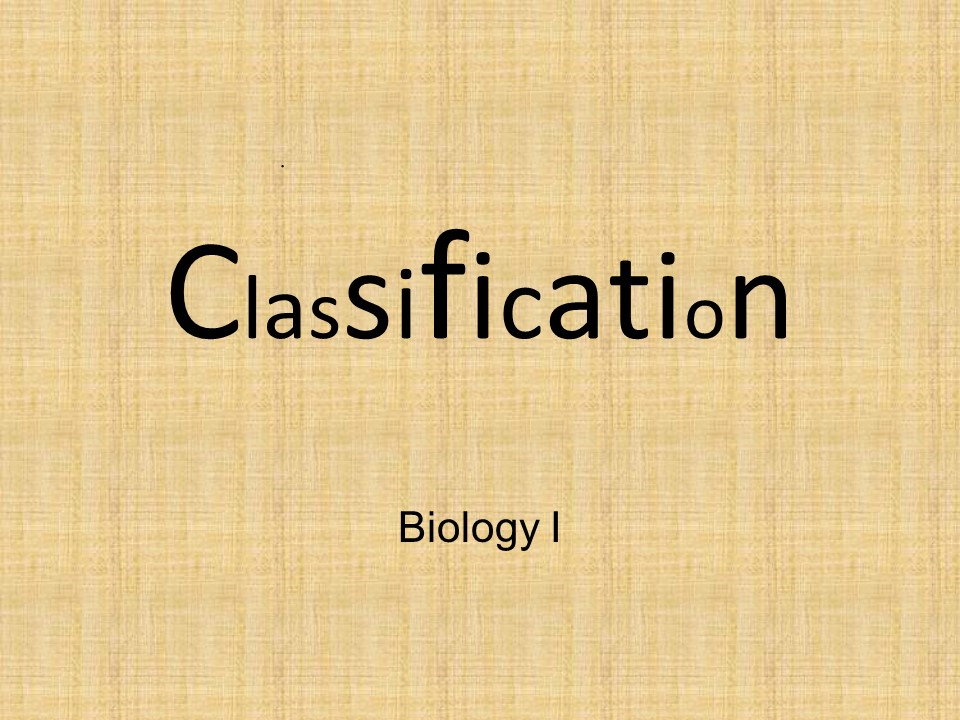Classification PowerPoint PPT Presentation
Title: Classification
1
Classification
- Biology I
2
Standards
- S7L1. Students will investigate the diversity of
living organisms and how they can be compared
scientifically. - a. Demonstrate the process for the development of
a dichotomous key. - b. Classify organisms based on physical
characteristics using a dichotomous key of the
six kingdom system (archaebacteria, eubacteria,
protists, fungi, plants, and animals).
3
1707-1778
4
Who was Linnaeus?
The father of modern taxonomy was Carolus
Linnaeus (Carl von Linné)
5
What are taxa?
- The science of classifying organisms is called
taxonomy - Organisms are grouped into taxa based on their
similarities to each other
6
The Old System
7
The old classification system is
5 Kingdom Classification System Monera all
prokaryotes Protista single-celled eukaryotes
(protists) Fungi multi-cellular heterotrophic
sessile eukaryotes Plantae multi-cellular
autotrophic sessile eukaryotes Animalia
multi-cellular heterotrophic motile eukaryotes
8
6 Kingdom Proposal
Archebacteria
EUbacteria
9
- 6 Kingdom Classification System
- Kingdom Eubacteria true bacteria
- (formerly in kingdom monera)
- Kingdom A rchebacteria extremophiles (formerly
in kingdom monera) - Kingdom Protista (same)
- Kingdom Fungi
- Kingdom Plantae
- Kingdom Animalia
10
(No Transcript)
11
What are the 3 Domains?
- 3 Domain System
- Archaea prokaryotes extremophiles
- Eubacteria prokaryotes true bacteria
- Eukarya eukaryotes
- Protista
- Fungi
- Plantae
- Animalia
12
What are the 8 levels of classification?
DomainKINGDOMPHYLUM CLASSORDERFAMILYGENUSSP
ECIES
13
(No Transcript)
14
What mnemonic do we use to remember the 8 levels
of classification?
Do
DomainKingdom KingsPhylum PlayClass
CardsOrder OnFamily FatGenus
GreenSpecies Stools
15
What is the most specific classification level?
- Organisms are grouped into smaller and smaller
groups all the way down to their species - A species is the most specific grouping and
includes only organisms that can interbreed with
each other and produce fertile offspring
16
Ursus americanus American Black Bear
17
How are organisms scientifically named?
Binomial Nomenclature a two-name system First
part of name genus first letter always
capitalized Second part of name species first
letter always lowercase Entire name is
underlined and italicized Names must be
submitted for acceptance by original discoverer,
and are generally Latin or Latinized
18
(No Transcript)
19
The Six Kingdoms
20
Domain Archaea
21
Domain Archaea
Formerly part of the kingdom monera Microbiologist
s who study bacteria determined that the DNA of
these are much different from other, true
bacteria Most Archaea live in extreme conditions
(very hot, acidic/basic, sulfurous, etc)
22
Domain Eubacteria
23
Domain Eubacteria
- Formerly a part of the kingdom monera
- Name means true bacteria
- These are the kind of bacteria likely to make us
sick, live in our gut to help us digest food, or
be used in the making of cheese - Bacilli
- Streptococcus
- Staphylococcus
- Dicoccus
- Spirilla
24
Domain Eukarya
25
Domain Eukarya
- Contains all of the eukaryotes (organisms with a
nucleus in their cells) - Protista
- Fungi
- Plantae
- Animalia
26
Kingdom Protista
Animal-Like (Protozoans)
Paramecium
Giardia
Amoeba
Fungus-Like
Plant-Like
Water Mold
Slime Mold
Diatom
Euglena
Brown Algae
Green Algae
Dinoflagellates
27
Kingdom Protista
Includes All Protists Eukaryotic Unicellular Anim
al-Like Protists (protozoans) Pseudopods,
Ciliates, Flagellates Examples Amoeba,
Paramecia, Giardia Plant-Like Protists
(autotrophic) Euglenoids, Dinoflagellates,
Diatoms, Green/Red/Brown Algae Fungus-Like
Protists Examples Water molds, slime molds
28
Kingdom Fungi
29
Kingdom Fungi
- All eukaryotic, multicellular, heterotrophic,
sessile organisms - Includes molds, mushrooms, rusts, lichens
- Mycorrhizal associations allow plants to absorb
more water and nutrients from the soil
30
Kingdom Plantae
Primitive Plants
Bryophyte (Moss)
Pteridophyte(Fern)
Complex Plants
Pteridophyte(Fern)
Coniferophytes (Pine Trees)
Angiosperm Dicot
Angiosperm Monocot
31
Kingdom Plantae
All eukaryotic, multicellular, autotrophic,
sessile organisms Produce their own food from
sunlight and carbon dioxide Common
Phyla Bryophyta (mosses) Pteridophyta
(ferns) Coniferophyta (conifers, like pine
trees) Angiospermophyta (angiosperms, like
flowering plants
32
Porifera
Ctenophora
Cnidaria
Nematoda
Platyhelminthes
33
Human Classification
34
Kingdom Animalia
- All eukaryotic, multicellular, heterotrophic,
motile (most) organisms - Common Phyla
- Porifera (sponges, corral)
- Cnidaria Ctenophora (jellyfish and similar
animals) - Platyhelmenthes (flat worms, tapeworms)
- Nematoda (small unsegmented worms)
35
Chordata
Arthropoda
Annelida
Molluska
Echinodermata
36
Human Classification
- Domain Eukarya
- Kingdom Animalia
- Phylum Chordata
- Class Mammalia
- Order Primates
- Family Hominidae
- Genus Homo
- Species Sapien
37
Note Guide
- Who was Linnaeus?
- What are taxa?
- The old classification system is________
Kingdoms - The new classification system there are_______
Kingdoms - What is the difference between the 3 domains?
- 1.
- 2.
- 3.
- What are the 8 levels of classification?
- 1)
- 2)
- 3)
- 4)
- 5)
- 6)
38
Note Guide (pg. 2)
- What mnemonic device do we use to remember the 8
levels of classification? - What is the most specific classification level?
- How are organisms scientifically named?
- What are the six kingdoms of life?
- 1)
- 2)
- 3)
- 4)
- 5)
- 6)
- How would you fully classify a human?

